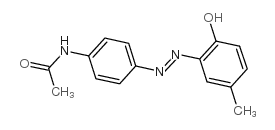Disperse Yellow 3

Disperse Yellow 3 structure
|
Common Name | Disperse Yellow 3 | ||
|---|---|---|---|---|
| CAS Number | 2832-40-8 | Molecular Weight | 269.29900 | |
| Density | 1.2 g/cm3 | Boiling Point | 533.9ºC at 760 mmHg | |
| Molecular Formula | C15H15N3O2 | Melting Point | 268-270 °C(lit.) | |
| MSDS | Chinese USA | Flash Point | N/A | |
| Symbol |


GHS07, GHS08 |
Signal Word | Warning | |
|
Multifunctional core-shell nanoparticles: discovery of previously invisible biomarkers.
J. Am. Chem. Soc. 133(47) , 19178-88, (2011) Many low-abundance biomarkers for early detection of cancer and other diseases are invisible to mass spectrometry because they exist in body fluids in very low concentrations, are masked by high-abundance proteins such as albumin and immunoglobulins, and are ... |
|
|
Assessment of the sensitizing potential of textile disperse dyes and some of their metabolites by the loose-fit coculture-based sensitization assay (LCSA).
Arch. Toxicol. 86(5) , 733-40, (2012) Certain textile disperse dyes are known to cause allergic reactions of the human skin. Here, we examined 8 disperse dyes and 7 products of azo-cleavage of these dyes in an in vitro assay. We used the loose-fit coculture-based sensitization assay (LCSA) of pri... |
|
|
Patch testing with the textile dyes Disperse Orange 1 and Disperse Yellow 3 and some of their potential metabolites, and simultaneous reactions to para-amino compounds.
Contact Dermatitis 67(3) , 130-40, (2012) It is known that, in vitro, human skin bacteria are able to split disperse azo dyes into the corresponding aromatic amines, some of which are sensitizers in the local lymph node assay. We hypothesize that the molecules of disperse dyes migrate onto the skin w... |
|
|
Textile dyes Disperse Orange 1 and Yellow 3 contain more than one allergen as shown by patch testing with thin-layer chromatograms.
Dermatitis 22(6) , 335-43, (2011) It is known that some patch-test preparations containing disperse dyes contain impurities with unknown relevance for the development or elicitation of contact allergy.To evaluate the significance of the impurities found in the commercial dyes Disperse Orange ... |
|
|
Effectiveness of disperse dyes mix in detection of contact allergy to textile dyes: an Italian multicentre study.
Contact Dermatitis 33(5) , 351, (1995)
|
|
|
Peroxidase-catalyzed oxidation of azo dyes: mechanism of disperse Yellow 3 degradation.
Arch. Biochem. Biophys. 312(1) , 301-7, (1994) Disperse Yellow 3 [2-(4'-acetamidophenylazo)-4-methylphenol] (DY3) (I) is an important yellow dye used in industry and is also a carcinogen. Earlier we demonstrated that lignin-degrading cultures of white-rot basidiomycete Phanerochaete chrysosporium degrade ... |
|
|
Case report: trouser dermatitis.
Australas. J. Dermatol. 26(2) , 80, (1985)
|
|
|
Disperse Yellow 3.
IARC Monogr. Eval. Carcinog. Risks Hum. 48 , 149-59, (1990)
|
|
|
Thin-layer chromatography search for Disperse Yellow 3 and Disperse Orange 3 in 52 stockings and pantyhose.
Contact Dermatitis 10(3) , 154-7, (1984) Thin-layer (uni-dimensional and bi-dimensional) chromatography studies were performed on 52 beige stockings and pantyhose from different countries. They demonstrated the presence of Disperse Yellow 3 in 51 and Disperse Orange 3 in 15 stockings. In the absence... |
|
|
Investigation of the sensitising and cross-sensitising potential of textile dyes and beta-lactam antibiotics using a biphasic mice local lymph node assay.
Arch. Toxicol. 83(7) , 691-9, (2009) We used a modified protocol of the murine local lymph node assay (LLNA) to study the cross-sensitising potential of (a) textile dye disperse yellow 3 and its metabolite 2-amino-p-cresol, (b) two antibiotics, penicillin G and cefotiam. The test substances were... |